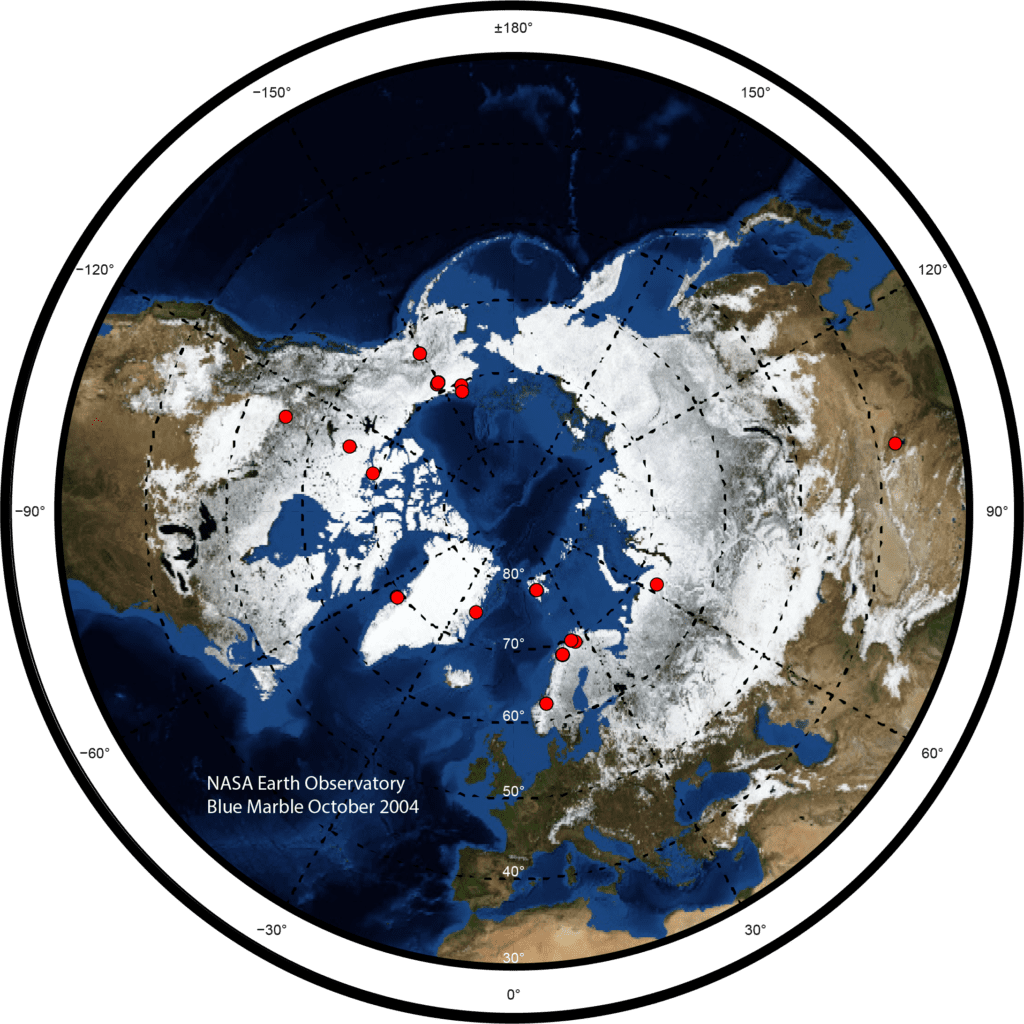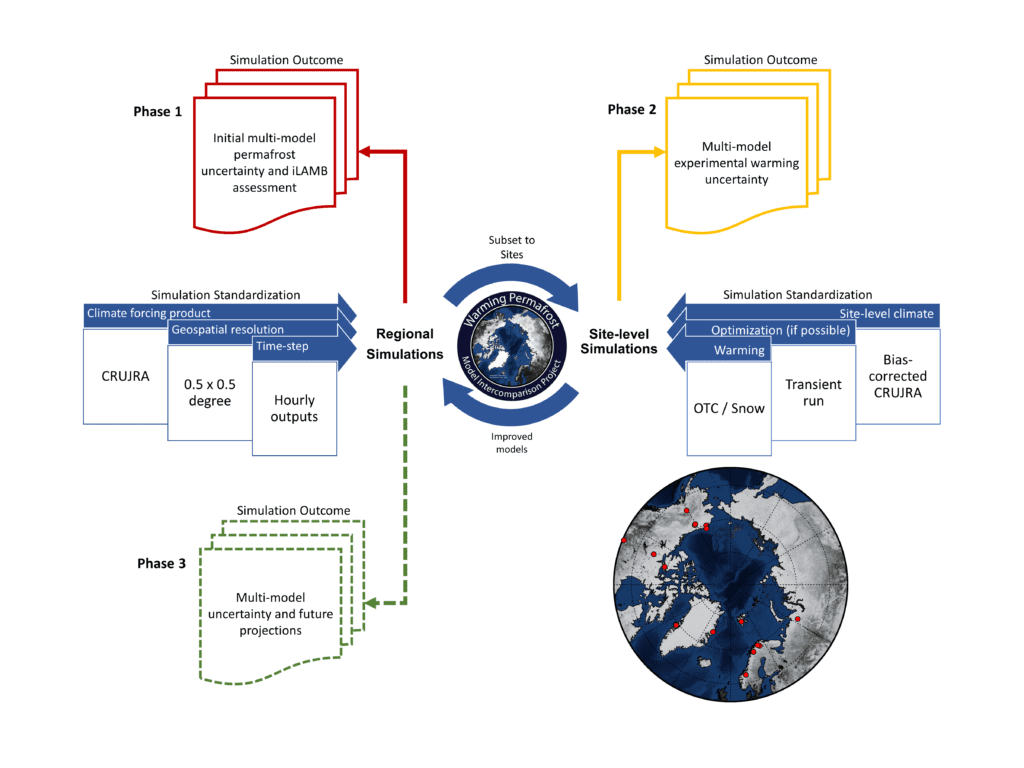
Project Plan
The WrPMIP is a multi-scale synthesis model intercomparison aimed at improving permafrost representation in current state-of-the-art carbon cycle models. Using an integrated evaluation framework, the project will develop site-level observationally-based climate forcing, standard simulation protocols across all participating models, and experimentally based permafrost warming benchmarks for future integration into frameworks like CMIP7 and ILAMB.
Phase 1 (2022):
The goal of the WrPMIP Phase 1 is to quantify variability across model estimates of abiotic response and land-atmosphere carbon exchange in areas of warming permafrost. We will approach this research from a regional perspective first as suggested in our first working group meeting that took place in June 2022. We expect to run regional model simulations with a baseline climate forcing product and implement two types of warming – open top chamber (OTC) warming (surface) and snow fence warming (deeper soil). This initial assessment will provide simulation outputs from which we can investigate the critical synthesis of model structural differences and their effect on simulated permafrost warming responses.
Phase 2 (2023):
During WrPMIP Phase 2, we plan to conduct site-level simulations to mimic warming at experimental sites. At the site-level we will attempt to minimize human time by minimizing or eliminating model optimizations as our key question is across scale and in comparison to observational benchmarks. We will provide a complement of bias-corrected climate forcing and surface datasets for participants to use.
Phase 3 (2024):
During WrPMIP Phase 3, we will focus on climate and emission scenarios defined by the Intergovernmental Panel on Climate Change (IPCC) and the CMIP6 protocol. This is also a period where we will aim to address potential model improvements. We aim to integrate synthesized knowledge into CMIP7 and ILAMB as current funding ends.
WrPMIP Protocol Planning – Phase 1
We modified our initial plan of starting with site-level runs to start with regional runs and minimal human effort. Below is a general overview of how we can approach the multiple phases in WrPMIP over the next 2 years.
Starting with regional runs (Phase 1), and an initial ILAMB assessment against developing observational benchmarks, we will simulate warming at the regional scale with consistent climate alongside two warming simulations: 1) OTC (surface warming) and 2) Snow fences (deep soil warming). Next we will run site-level runs (Phase 2) to check for direct comparison to measured warming responses and to test coherence of responses across scales. From what we learn through the initial project phases we can then implement model improvements and assess subsequent regional runs and future scenario projections (Phase 3).

Figure 1. WrPMIP simulation overview.
| Phase | Experiment | Input | Historical 1901-2021 |
Future 2021-2100 |
Extended 2100-2300 |
|---|---|---|---|---|---|
| 1 | a. Regional Baseline (low temporal resolution) | Climate, CO2 | CRUJRA (1901-2000) | Not simulated | Not simulated |
| b Regional baseline (high temporal resolution) | Climate, CO2 | CRUJRA (2000-2021) | Not simulated | Not simulated | |
| c. Regional OTC Warming | Climate, CO2 | CRUJRA (2000-2021) | Not simulated | Not simulated | |
| d. Regional Snow Fence Warming | Climate, CO2 | CRUJRA (2000-2021) | Not simulated | Not simulated |
Phase 1 Simulations
WrPMIP Protocol Planning – Phase 2
The main focus of the WrPMIP project is to complete site-level runs to replicate experimental warming. Here we would like to improve climate forcing products through bias-correction to limit uncertainty to differences in model performance and warming perturbation responses. Bias-correction was conducted for CRUJRAv2.3 (1901-2021).
| Phase | Experiment | Input | Historical 1901-2021 |
Future 2021-2100 |
Extended 2100-2300 |
|---|---|---|---|---|---|
| 2 | Site-level Baseline | Climate, CO2 | Bias-corrected CRUJRA | Not simulated | Not simulated |
| Site-level OTC Warming | Climate, CO2 | Bias-corrected CRUJRA | Not simulated | Not simulated | |
| Site-level Snow Fence Warming | Climate, CO2 | Bias-corrected CRUJRA | Not simulated | Not simulated | |
| Site-level Snow Fence Warming w/ Snow Removal | Climate, CO2 | Bias-corrected CRUJRA | Not simulated | Not simulated |
Phase 2 Simulations
WrPMIP Protocol Planning – Phase 3
This phase would be towards the end of the project’s funding window in 2024. Here we would run regional simulations of climate change scenarios. There is potential to use ISIMIP climate scenarios or other products to make our simulations comparable to other MIPs in some ways. There is also potential time to look into other science questions that were not covered in the first two phases. In this window there is freedom to explore model improvements, future projections and scenarios, and specific permafrost questions like modeling ground ice, rapid thaw, or other model induced warmings. That said, we will plan this phase over the next year with input from the WrPMIP group and have.
| Phase | Experiment | Input | Historical 1901-2021 |
Future 2021-2100 |
Extended 2100-2300 |
|---|---|---|---|---|---|
| 3 | Site-level Model Optimization | Climate, CO2 | Bias-corrected CRUJRA | Not Simulated | Not Simulated |
| Site-level Projections | Climate, CO2 | Not simulated | TBD; Based on observational data | TBD; Based on observational data | |
| Pan-Arctic Projections* | Climate, CO2 | Not simulated | SSP1-2.6 | SSP1-2.6** | |
| Climate, CO2 | Not simulated | SSP2-4.5 | SSP2-4.5** | ||
| Climate, CO2 | Not simulated | SSP5-8.5 | SSP5-8.5** | ||
| Specific Topics (permafrost C Pool sizes, rapid thaw and subsidence, ground ice, etc.) | TBD | TBD | TBD | TBD | |
| *Subset of IPCC AR6 priority scenarios | **Extensions of SSPs by Meinshausen et al. 2020 | ||||
Phase 3 Simulations


